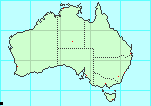
Common Name:
Delete this section if there is no common name.
Identification:
Length:
Coloring:
Note any distinguishing features.
| body | 35 mm.
width, 1-1.3 mm. |
| head | 1.6 mm. |
| pronotum | 1.4 mm. |
| mesonotum | 9.5 mm. |
| metanotum | 6.5 mm. |
| abdomen | 16 mm. |
| ant. femora | 11 mm. |
| ant. tibiæ | 11 mm. |
| med. femora | 8 mm. |
| med. tibiæ | 8 mm. |
| post. femora | 10 mm. |
| post. tibiæ | 7.5 mm. |
Two males.
Body pale ochreous to dull blackish-brown, filiform, thorax carinated.
Head pale dull ochreous, with two interrupted black vittæ behind
the eyes, an ovate, longitudinal impression anteriorly, on either side
of which a fine distinct ridge, bind margin crenate.
Eyes yellowish-grey.
Antennæ as long or longer as anterior femora, first joint long,
flat, next two very short and thick, remainder shorter than first,
subequal, filiform.
Pronotum rough, dull, same colour as head, wider behind, anterior margin
suberenate, forming a distinct ridge, median carina very fine, marginal
ridges distinct, intra-marginal carina rather broad.
Mesonotum with subparallel sides, raised median and submarginal ridges,
dark brown.
Metanotum similar, ridges much more distinct,
both meso- and metanotum very minutely papillose between the raised lines,
and of the same width.
Abdomen very slender, apparently fiat underneath, brown in the dried
specimens, tapering towards apex.
Legs triquetrous, with one or two carina on each face, unarmed.
Supra-anal lamina very short, triangular.
Cerci not exceeding apex.
 Note parental placement of eggs.
Note appearance of eggs.
Note any common variations.
Note parental placement of eggs.
Note appearance of eggs.
Note any common variations.
Habitat:
Note if the species arborial or terrestrial.
Canopy, mid, under, etc.
Note typical vegetation, e.g.
tropical rainforest, temperate rainforest,
grasslands,
alpine, etc.
Similar Species:
Rearing Notes:
Note if this species has ever been reared.
Note any suggestions for successful rearing.
For a stick insect with body length 35mm, to keep 2 adult females,
you need a cage at least 160mm high, 70mm deep and 70mm wide.
 Range:
Range:
W plateau, SA
Status:
It is not known if this species is endangered,
as there is insufficient sighting history.
References:
-
Balderson, J., Rentz,
D.C.F. and Roach, A.M.E. (1998).
in
Houston, W.K.K. & Wells, A. (1998) (eds)
Zoological Catalogue of Australia.
Vol. 23.
Archaeognatha, Zygentoma, Blattodea, Isoptera, Mantodea, Dermaptera,
Phasmatodea, Embioptera, Zoraptera.
Melbourne: CSIRO Publishing, Australia (ISBN 0643 06035 9).
pp. 347 - 376.
-
Tepper, J.G.O. (1905).
Insects collected in the North-western Region of South Australia Proper
by H. Basedow; with Descriptions of New Species of Mantidæ and
Phasmidæ, No. 2.
Transactions of the Royal Society South Australia, 29: 237-245.
-
Vickery, V.R. (1983).
Catalogue of Australian stick insects (Phasmida,
Phasmatodea, Phasmatoptera, or Cheleutoptera). CSIRO
Australian Division of Entomology Technical Paper, No. 20, 15 pp.
- Search Google for
Bacillus peristhenellus,
or search Google Scholar for
Bacillus peristhenellus.
Copyright © 2000-2003
Peter Miller
This page was last changed 20-Sep-2006.
|

|

|
 Note parental placement of eggs.
Note appearance of eggs.
Note any common variations.
Note parental placement of eggs.
Note appearance of eggs.
Note any common variations.

 Note parental placement of eggs.
Note appearance of eggs.
Note any common variations.
Note parental placement of eggs.
Note appearance of eggs.
Note any common variations.
 Range:
Range: 
